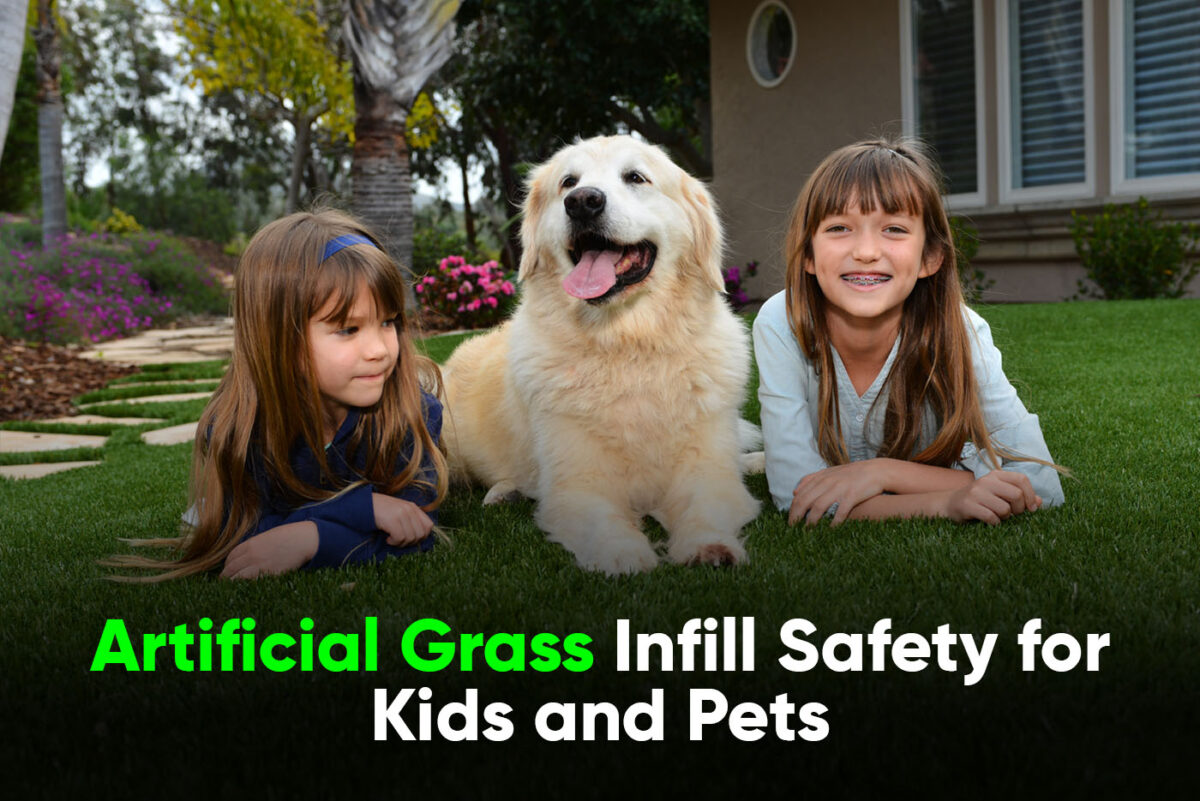- BACKYARD
- COMMERCIAL
- ENVIRONMENT
- FIELD TURF NEWS
- GOLF
- MAINTENANCE
- NEWS
- PETS
- POOL
- RESIDENTIAL
- TURF TIPS
Keeping Your Family Safe with Artificial Grass Infill

As you consider playground turf installation for your home, you may be wondering about the small granules that make up the base layer, known as infill. What exactly is infill, and is it safe for kids?
These are important questions when choosing the right artificial grass products for your home. As a caring parent, you want to make sure your outdoor spaces are fun for playtime, yet free of hazards.
In a nutshell, infill plays a critical role in making modern artificial grass safe, soft, and realistic. Let’s go over it below.
What Is Infill and Why Do We Use It?
Infill refers to the materials packed between the blades of artificial grass to support the upright fibers and emulate a natural lawn. It usually consists of small granules that cushion the synthetic blades while allowing stability and drainage.
Without infill, artificial grass would be flat and thin, with a hard plastic feel underfoot. The infill gives bounce and cushioning for sports and playtime, protecting against injuries from falls. It also protects the grass fibers from excessive wear to increase durability.
Some common infill options include:
- Sand Infill
Pure silica sand particles offer great affordability and drainage without compacting too heavily. This is a good choice for simple landscape applications. However, sand infill requires more maintenance to prevent spreading and doesn’t offer as much shock absorption.
- Rubber Infill
Typically made from recycled tires, rubber infill provides excellent durability, drainage, and shock absorption for active play. Modern rubber infills are 99% free of metals and toxins, though you can also choose alternative rubber made from safer, sustainable sources.
- Coated Silica Infill
For a premium option, coated silica offers vibrant colors that resist fading, plus controlled moisture retention. The coated granules are heavier than regular sand, requiring less infill depth for stability. This type blends safety, comfort, and low maintenance.
- Organic Infill
Sourced from natural materials like cork, coconut husks, or walnut shells, organic infill offers sustainability and safety. However, it compacts more heavily than other options and needs frequent fluffing. Organic infill works best for low-traffic areas.
Why FieldTurf Artificial Grass Infill is Safe
Here are some of the ways we guarantee the safety of our infill products here at FieldTurf Landscape, especially for play spaces:
1. Materials Used: We select the materials commonly used for our various infill products, such as crumb rubber (from recycled tires), silica sand, and alternative organic options like cork or coconut fibers, for their non-toxicity and durability.
2. Manufacturing Process: During manufacturing, these materials are treated and processed to ensure they are free from contaminants. For instance, rubber is cleaned and ground into small, uniform particles, while organic options are processed to remove any natural impurities.
3. Testing for Safety: Infill materials undergo rigorous testing to ensure they meet safety standards. This includes testing for heavy metals, volatile organic compounds (VOCs), and other potential toxins. The testing ensures that the infill does not release harmful substances into the environment or pose a health risk to you and your loved ones.
4. Shape and Texture: The shape and texture of infill particles we use for playground turf for backyard are designed to provide cushioning and stability. Rounded or sub-angular shapes are preferred as they provide the right balance of firmness and flexibility, minimizing the risk of injuries from falls or slips that often happen during play time.
5. Special Infill Coatings: Some infill materials are coated with additives to enhance their properties. For example, coatings may be applied to rubber to reduce dust, prevent microbial growth, or minimize heat absorption. These coatings are also made from safe, non-toxic materials.
6. Environmental Stability: We choose the materials for our infill products based on their ability to withstand environmental factors like UV radiation, temperature changes, and moisture. This stability ensures that the infill does not break down into hazardous substances over time.
7. Non-Flammability: Infill materials are often non-flammable or have flame-retardant properties, adding an extra layer of safety, especially if you live in dry, hot climates.
Have More Questions? Contact Us Today!
If you still have concerns about infill safety or want advice choosing synthetic turf for playgrounds and backyards, please reach out anytime.
We’re also happy to send over product spec sheets, more information about our safety certifications, and anything else to help you make the best decision for your home and family.
Call us at 866-352-4575 or send us a message using this form to get started.


